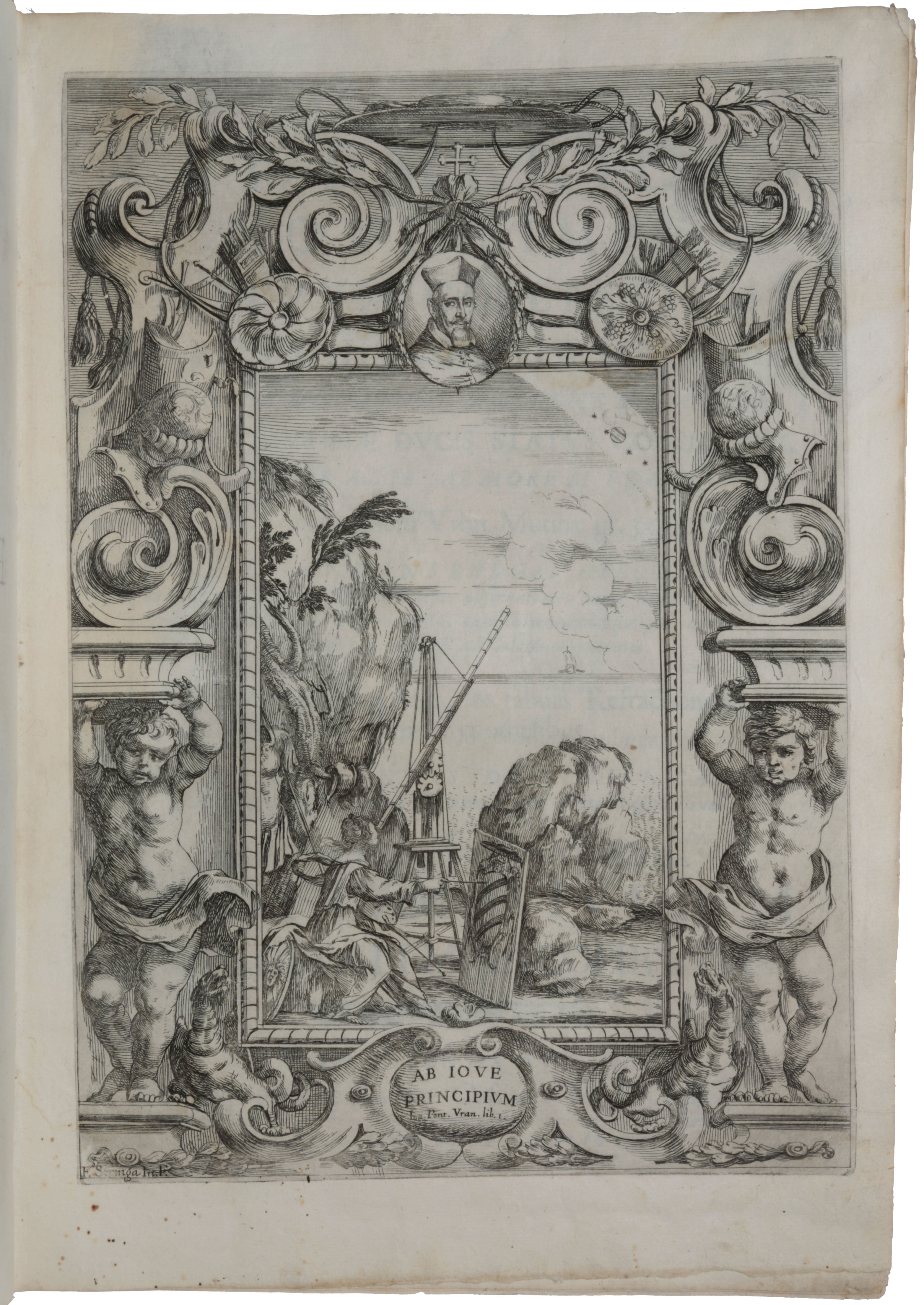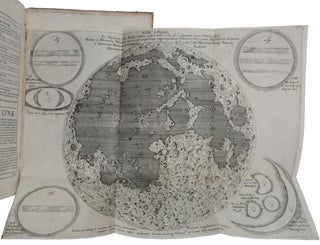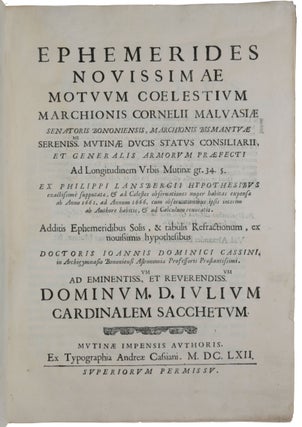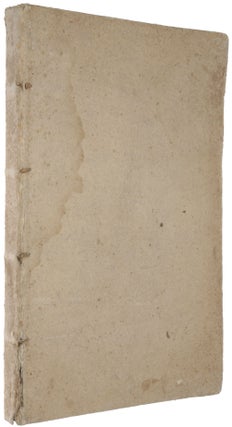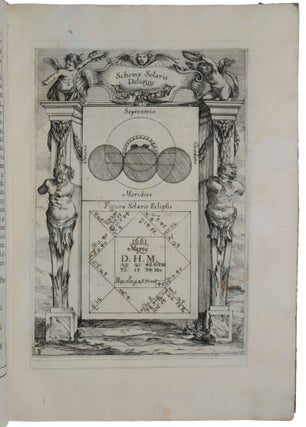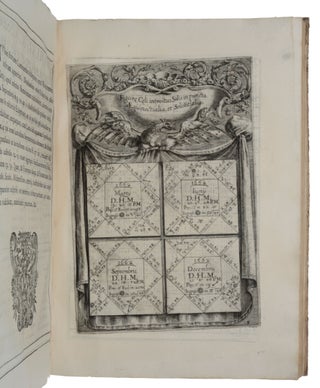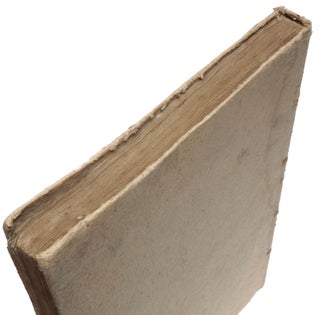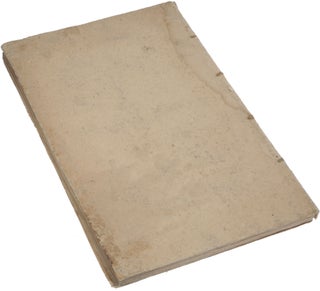Ephemerides novissimae motuum coelestium … ad longitudinem urbis Mutinae gr.34.5. Ex Philippi Lansbergii hypothesibus … supputatae … Additis ephemeridibus solis, & tabulis refractionum, ex novissimis hypothesibus doctoris Ioannis Dominici Cassini.
Modena: impensis Authoris ex Typ. Cassiani, 1662. First edition of these very rare ephemerides, containing one of the most detailed lunar maps up to that time. Cornelio Malvasia (1603-63), a wealthy nobleman and amateur astronomer from Bologna, made his astronomical observations in the private observatory he built over his villa in Panzano, near Modena. Amongst his collaborators was Geminiano Montanari (1633-87). Malvasia also did much to foster the talent of the young Gian Domenico Cassini (1625-1712), whom he recommended for the chair of astronomy at Bologna University. Montanari became skilled in the design and construction of astronomical instruments. To make the lunar map in the present work, Montanari used a telescope together with a ‘reticule’, an early form of bifilar micrometer, designed by Malvasia. The present work was dedicated to Cardinal Giulio Cesare Sacchetti – twice nominated by Antonio Barberini as the French candidate for pope – and included a rather laudatory dedication in which Malvasia claimed he could trace Sacchetti’s ancestry back to Ancient Roman gods. In the long preface, ‘De institutione ratione’, in which Malvasia expresses his esteem and fraternal affection for Cassini but where unfortunately there is no mention of the substantial contribution of the young Montanari, Malvasia outlines the plan of the work and cites some of the major compilers of ephemeredes that preceded it, the various Argolis (often criticized), Placido de Titiis and Montebruno. This is followed, in the classic seventeenth-century style, by some bombastic and flattering Latin and Italian poems, dedicated to the Malvasia by Andrea Mariani, by Cassini and Montanari, and by Giacinto Onofrio. The ephemerides themselves contain much information on important astronomical quantities, including the values of the obliquity of the ecliptic, the precession of the equinoxes, the date of Easter, and the forecast of the eclipses of the Sun and Moon. The work is illustrated by a magnificent frontispiece and beautiful full-page plates showing astrological tables framed by elaborate and richly decorated borders engraved by the artist Francesco Stringa. Although reasonably well represented (although by no means common) in institutional collections, this is a very rare work in commerce. ABPC/RBH lists only two copies in the last half-century (one with significant defects and erased stamps). During the Wars of Castro, Malvasia led the papal army cavalry against the Dukes of Parma. Despite the Duchy of Modena having sided with the Dukes of Parma during the Wars of Castro, Malvasia later became a military advisor to Alfonso IV d'Este, Duke of Modena. He was later named Marechal of the French army in Italy. In 1656 he visited Paris and received honours from King Louis XIV of France. Throughout his military career, Malvasia maintained a strong general interest in astronomy, optics and scientific engineering. Malvasia was elected a Senator of Bologna and began construction of the privately owned Panzano Observatory in the early 1640s. This observatory hosted many astronomers, and even the Duke of Modena, Francesci I d’Este, made observations from this site. In 1645 Malvasia invited Cassini to Bologna and offered him a position in his observatory, which was close to completion. Most of their time was spent calculating newer, better, and more accurate ephemerides for astrological purposes using the rapidly advancing astronomical methods and tools of the day. In Cassini’s memoirs from the time, he writes: “‘He [Marquis Malvasia] used to print every year an astrological journal which he then gifted to his friends. I [Cassini] pointed out to him that it would have been more honourable to calculate the most modern tables of astronomical ephemerides, leaving aside the astrological predictions, which have no solid basis.’ … “As he reports at the end of this anecdote, in this case he prevailed and managed to convince the Marquis: ‘This good advice that I gave him was soon confirmed by a singular event that made him recognize that it was only by chance that the astrological predictions had some success. His almanac had foretold a great storm for a certain day, and on that very day a hurricane and a furious hailstorm devastated the surrounding farmland. The Marquis Malvasia came to me with his book to convince me of the precision of this prediction. ‘Well,’ I replied, ‘but les us see on which basis you came to these conclusions, and let us review the calculations.’ This was done immediately. But he found himself, to my great satisfaction, that, because of a misprint in the ephemeris, he had used a configuration that was not possible, and according to which the senator had concluded the event of a storm that would not have happened if the ephemeris had been true. From that moment Malvasia resolved to calculate himself the new ephemeris’” (Bernardi, pp. 19-20). “At the beginning of 1661, the duke of Modena invited [Montanari] to return to that city as court philosopher and mathematician. The appointment was a brief one—Alfonso IV died in July 1662—but during this time, he met Cornelio Malvasia, a Bolognese nobleman, who commanded the duke’s militia and who was passionately interested in astronomy. An active patron of talented scientists, in 1650 he had recommended to the Bolognese Senate G. D. Cassini, who, had worked for him in the observatory that Malvasia had built in his house at Panzano, near Castelfranco, Emilia. Now Malvasia became interested in Montanari, who helped him to compile his volume of ephemerides (Modena, 1662) covering 1661-66” (DSB, under Montanari). Perhaps the most notable feature of the Malvasia/Montanari ephemerides is the beautiful lunar map. Montanari began his surveys of the moon on October 15, 1662, about three and a half days after the new moon, preferring to wait for the excessive light of the full moon to fade, as a result of which, in his opinion, many details would have been lost. To accurately plot the position of the features of the moon. Montanari used the reticule devised by Malvasia. “It consisted of a network of fine silver wires which divided the field into a number of equal squares of known size. Malvasia used it for plotting the positions of craters on the moon, measuring the distance between any two craters by counting the number of whole squares between them. Seldom did two craters or two stars fall exactly on the wires and the observation was thus subject to the errors of eye-estimation” (King, p. 98). Montanari divided the lunar disk into exactly nine intervals on both axes. In this way the moon appeared to him through a dense grid of eighty-one squares. On a large sheet of paper, where he had previously drawn a circle of thirty-eight centimeters in diameter, he superimposed a grid of as many squares and began to outline the lunar cartography. In addition to its accuracy, Montanari’s map stands out for its analytical, almost geometric form, far removed from the somewhat imaginative style of its predecessors. “The allegorical frontispiece shows a young woman observing Jupiter with a telescope while she paints a coat of arms, which contains the stripes of the planet. In the dedicatory epistle to cardinal Giulio Sacchetti (whose portrait appears on the top of the frontispiece) the author explains that, during his observations, he had observed that the Sacchetti coat of arms is striped like Jupiter, whence a supposed origin of the family from the planet, in honour of the cardinal. In the frontispiece the young woman eventually depicts a coat of arms, with three stripes that go in the reverse direction from those of planet Jupiter, visible in the sky. The engraving is by Francesco Stringa (Modena, 1635-1708), a portrait painter from the school of Guercino, who was the favourite artist at the Este court. He was part of the circle known to the anatomist Malpighi” (Macclesfeld Catalogue). Pogendorff II, 30; Houzeau & Lancaster 15250; Riccardi II, 77; not in Honeyman or Norman. Bernardi, Giovanni Domenico Cassini, 2017. King, The History of the Telescope, 2003.
Folio (370 x 255 mm), pp. [xxiv] (including engraved frontispiece), 220 (all framed by typographic border), one large folding plate illustrating the moon, 12 full-page plates within the text (light water-stain in the gutter). Contemporary cartonnage.
Item #5401
Price: $65,000.00

